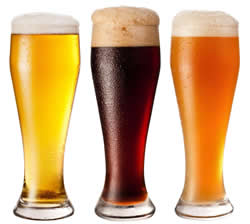Difference between Whiskey, Rum, Vodka, Brandy, Scotch and Beer
Key Difference: Whiskey or whisky is a type of distilled alcoholic beverage made from any form of fermented grain mash such as barley, malted barley, rye, malted rye, wheat, and corn. Rums are distilled alcoholic beverages made from sugarcane byproducts such as molasses or sugarcane juices that go through the process of distillation, fermentation and aging. Vodka is a distilled spirit that is composed of water and ethanol that is made by distilling juices from various fermented substances such as grains, potatoes and sometimes sugar or fruit. Brandy, short for brandywine is a sprit that is distilled from wine, grapes and other fruit juices. Scotch or scotch whiskey is actually a type of whiskey that is processed in Scotland. Beer is commonly made from malted barley or malted wheat and flavored with hops, herbs or fruits (occasionally).

Alcoholic drinks serve a variety of purposes today. It is present at almost every event such as a party or a get-together. It can also be served as an ice breaker on a new date or as many people claim it help drown out sorrows and other worries. They have practically become a main part of our culture. There are a variety of different alcoholic beverages that can be consumed including vodka, whiskey, gin, rum, scotch, tequila, etc. However, each drink differs in terms of flavor, appearance, process of making etc.
Whiskey or whisky is a type of distilled alcoholic beverage made from any form of fermented grain mash. Depending on the geographical region or type of whiskey that is being made, whiskey can be made from barley, malted barley, rye, malted rye, wheat, and corn. They are often aged in charred barrels. According to Wikipedia, the word ‘whiskey’ is the anglicisation of the Gaelic word ‘uisce|uisge’ meaning “water”. Distilled water was known in Latin as aqua vitae meaning “water of life”. The process of distillation can be dated back to the Greeks in Alexandria around the 3rd century AD; however they did not distill alcohol only spirits for fragrance purposes. The distillation process was passed down through the ages to Italy in the 13th century AD where the first distillation process of alcohol took place and alcohol was distilled from wine. The alcohol was originally used for medicinal purposes before it become consumable as a beverage. Whiskey first become popular as a beverage in Scotland before it spread to other neighboring countries.
There are various different types of whiskey and they differ in terms of base product, alcoholic content and quality. The main two types include malt whisky and grain whisky. Malt whisky is made primarily from malted barley, while grain whisky is made from any type of grain. Malting is when the grain is put under the process of germination. Germination requires the barley being placed in water for a certain amount of time and being constantly turned to ensure proper soaking. Whiskies can further be classified under:
- Single malt whisky: is whisky that is from a single distillery and is made from a mash that uses only one particular type of malted grain.
- Blended malt whisky: is a blend of different malt whiskies from different distilleries.
- Blended whiskies: is whiskey that is made from a mixture of malt and grain whiskies along with neutral spirits, caramel, and flavoring.
- Cask strength: These whiskies are bottled directly from the cask and are undiluted or only a little diluted. These are rare whiskies.
- Single cask: Each bottle of a single barrel whiskey is from an individual cask with the cask number labeled on the bottle.
Whiskies must be strengthened and aged in a barrel. They do not mature in the bottle, hence if a person keeps the whiskey bottle over a long time, it would not become any stronger in flavor or alcohol content. The alcohol content and mash content varies depending on the regulations of the geographic region. The whiskies require a charred oak barrel during the aging process, which provides them with the golden brown and amber coloring. Additional flavors and colors can be added to the alcohol depending on the regulations.

Rums are distilled alcoholic beverages made from sugarcane byproducts such as molasses or sugarcane juices. Similar to most alcoholic beverages, rums must go through the process of distillation, fermentation and aging. Depending on the geographical region of the product, rums differ in taste, color and strength. The origin of the term ‘rum’ is unclear and there are various different possibilities as to how the name came by. British etymologist, Samuel Morewood in his 1824 essay stated that the word ‘rum’ was a British slang term from “the best”. Morewood also suggested another possibility that the word was taken from the last syllable of the Latin word, “saccharum”, meaning “sugar”. Other possibilities include the word being derived from other popular British drinks of the time such as ramboozle and rumfustian.
Majority of the rum in the world is produced in the Caribbean and Latin America, with selected other countries such as India, Spain, New Zealand, Mexico, etc. also partaking in producing the beverage. Rum was first distilled on a sugarcane plantation in the Caribbean during the 17th century. The slaves at the plantation discovered that molasses, a byproduct of sugarcane when it is refined into suger, could be fermented into alcohol. Other places to record early rum distillation include Brazil and Barbados. After the development of rum, it grew fast in demand and it was also used in many places as currency. To support the increasing demand of sugar, labor was required to work the sugar plantations. This resulted in the establishment of the triangular trade between Africa, the Caribbean and the European colonies. Rum also became popular with seamen and pirates.
Rum does not have any set production methods, with the methods varying depending on the region where the distillers are located. Similar to some other alcoholic beverages, rum goes through the process of fermentation of either molasses or sugarcane juice. During fermentation, the water and yeast is added to the base ingredient, allowing the yeast to break down the sugar. Depending on the type of yeast used for fermentation, the taste and aroma of the rum varies. After distillation, the rum is then put through the process of distillation. After distillation, the rum is required to be aged for at least one year in many countries. The aging process could be done in wooden casks (natural or charred) as well as in stainless steel tanks. The rum in the wooden casks is darker in appearance, while the rum in stainless steel tanks remains colorless. Caramel can also be added to rum to adjust the color of the final product before it is bottled.
According to Wikipedia, rum comes in certain grades and variations. They can be classified under the following:
 Light rums: Light rums are rums that are light or clear in color. They can also be referred to as white rum. They have very little flavor and are used in cocktails.
Light rums: Light rums are rums that are light or clear in color. They can also be referred to as white rum. They have very little flavor and are used in cocktails.- Gold rums: Gold rums are also known as amber rums. They are often aged in charred white oak barrels. They have a stronger flavor compared to light rums.
- Dark rums: These are darker in color such as black, red or brown. They are aged for a longer period of time in heavily charred barrels. They may also have a hint of spices and caramel to adjust the color and flavoring. They are stronger and sweeter compared to the light and gold rums.
- Spiced rums: These rums obtain the flavor from spices or caramel. They are dark in color and may have spices such as cinnamon, rosemary, absinthe/aniseed, or pepper.
- Flavored rums: These rums are infused with additional flavors such as banana, coconut, citrus, etc.
- Overproof rums: These rums are higher in proof and ABV.
- Premium rums: These rums are high priced and are carefully aged and produced. They are said to have more flavor and taste.
Vodka is a distilled spirit that is composed of water and ethanol. It is made by distilling juices from various fermented substances such as grains, potatoes and sometimes sugar or fruit. The distillation from sugar and fruit are also sold as flavored vodka. Vodkas were introduced in the United States after 1940s, before this time it was sold in countries such as Belarusian, Polish, Russian and Lithuanian. The traditional vodkas are 40% alcohol by volume (ABV) or 80 proof. In European Union, requires vodkas to have minimum 37.5% ABV for any "European vodka" to be known as vodka. The United States requires minimum 30%.
The term ‘vodka’ is derived from the Slavic word voda (water) and is often believed to refer to vodka as little water due to its clear color. Traditionally, vodka was a drink that was expected to be consumed neat (without any additives) in the vodka belt countries of Eastern Europe. However, these days vodka plays a main ingredient in many cocktails including Bloody Mary, Screwdriver, Sex on the Beach, Moscow Mule, White Russian, Black Russian, etc. It can also be consumed with soft drinks or is often great for mixing with gin and tonic.
 Brandy, short for brandywine is a sprit that is distilled from wine, grapes and other fruit juices. The word ‘brandywine’ is derived from the Dutch word ‘brandewijn’ meaning “burnt wine”. Brandies are more commonly considered as an after-dinner drink and can contain alcohol by volume (ABV) between 35% and 60%. The origins of brandy can be dated back to the development of distillation to ancient Greece and Rome. However, modern brandy can be dated back to the 12th century. Brandies are made using grapes or any fruits that can produce a sugary juice. According to Encyclopaedia Britannica, brandy can also be used to refer to spirit made from pomace and other fermented fruit. However, if the brandy is made from any other fruit instead of grapes, many countries require it to be labeled as ‘fruit brandy’, ‘fruit spirit’, or the name of the fruit should be mentioned on the bottle. The regulations for producing and labeling differ depending on the jurisdiction.
Brandy, short for brandywine is a sprit that is distilled from wine, grapes and other fruit juices. The word ‘brandywine’ is derived from the Dutch word ‘brandewijn’ meaning “burnt wine”. Brandies are more commonly considered as an after-dinner drink and can contain alcohol by volume (ABV) between 35% and 60%. The origins of brandy can be dated back to the development of distillation to ancient Greece and Rome. However, modern brandy can be dated back to the 12th century. Brandies are made using grapes or any fruits that can produce a sugary juice. According to Encyclopaedia Britannica, brandy can also be used to refer to spirit made from pomace and other fermented fruit. However, if the brandy is made from any other fruit instead of grapes, many countries require it to be labeled as ‘fruit brandy’, ‘fruit spirit’, or the name of the fruit should be mentioned on the bottle. The regulations for producing and labeling differ depending on the jurisdiction.
The process of producing brandy requires fermenting the wine, fruit juice or grapes for 4-5 days after which they are distilled, using either pot-stills or column-still, before they are put into casks for aging. There is no set time required for aging as some fruit juices do not require aging. The aging process determines the color of the brandy; if it is not aged the brandy is colorless or clear and the longer it is aged the stronger the color of the brandy. Some brandy may also be added with caramel to adjust the color and the flavor of the beverage. Distillation must differ depending on the type of brandy being produced. For example, wine with ABV 8% to 12% and high acidity is boiled in a pot still. Brandy made from grapes also requires being distilled twice or more to acquire the required aroma and flavor.
 Brandy is labeled in a certain way that shows the quality of the brandy. Labels include A.C. (aged 2 years), V.S. (very special, aged 3 years), V.S.O.P. (Very Superior Old Pale, aged at least 5 years), X.O. (Extra Old, aged at least 6 years), Vintage (the label shows the date it was placed into the cask) and Hors d'age (Too old to determine age, commonly more than 10 years). Other names for brandy include cognac and Armagnac, named after the place they were produced.
Brandy is labeled in a certain way that shows the quality of the brandy. Labels include A.C. (aged 2 years), V.S. (very special, aged 3 years), V.S.O.P. (Very Superior Old Pale, aged at least 5 years), X.O. (Extra Old, aged at least 6 years), Vintage (the label shows the date it was placed into the cask) and Hors d'age (Too old to determine age, commonly more than 10 years). Other names for brandy include cognac and Armagnac, named after the place they were produced.
Scotch or scotch whiskey is actually a type of whiskey that is processed in Scotland. The term is legally reserved to whiskey that is produced in Scotland. It is originally made from malt barley, but during the 18th century distilleries started producing whiskies made from wheat and rye. In short, scotch is basically just a whiskey that was produced in Scotland, nothing more. According to the Scotch Whisky Regulations, scotch must be aged in oak barrels for at least three years. First written mention of Scotch whisky was in the Exchequer Rolls of Scotland, 1495 by a friar named John Cor, who was a distiller.
Scotch Whisky Association classifies scotch into five distinct categories.
- Single malt Scotch whisky: This whisky is produced from only water and malted barley at a single distillery by batch distillation in pot stills.
- Single grain Scotch whisky: This whisky is distilled at a single distillery, but it can also include whole grains of other malted or unmalted cereals, in addition to malted barley and water.
- Blended malt Scotch whisky: This whisky includes a mixture of two or more single malt Scotch whiskies from different distilleries
- Blended grain Scotch whisky: This whisky includes a mixture of two or more single grain Scotch whiskies from different distilleries.
- Blended Scotch whisky: This whisky includes a mix of one or more single malt Scotch whiskies with one or more single grain Scotch whiskies.
The Scotch Whisky Regulations 2009 set by the Scotch Whiskey Association defines ‘scotch’ as:
- Produced at a distillery in Scotland from water and malted barley (to which only whole grains of other cereals may be added) all of which have been:
- Processed at that distillery into a mash
- Converted at that distillery to a fermentable substrate only by endogenous enzyme systems
- Fermented at that distillery only by adding yeast
- Distilled at an alcoholic strength by volume of less than 94.8% (190 US proof)
- Wholly matured in an excise warehouse in Scotland in oak casks of a capacity not exceeding 700 liters (185 US gal; 154 imp gal) for at least three years
- Retaining the color, aroma, and taste of the raw materials used in, and the method of, its production and maturation
- Containing no added substances, other than water and plain (E150A) caramel coloring
- Comprising a minimum alcoholic strength by volume of 40% (80 US proof)
 Beer is one of the most popular alcoholic beverages that is available and consumed world-wide. It is also the third most popular drink following water and tea. Beer is an alcoholic beverage produced by the saccharification of starch and fermentation of the resulting sugar. Beer is commonly made from malted barley or malted wheat and flavored with hops, herbs or fruits (occasionally). Beer has been around since the early Neolithic or 9500 BC, when cereal was farmed. The first recorded history of beer is found in the texts of ancient Egypt and Mesopotamia. According to many archeologists, beer may have been a crucial instrument in forming civilizations.
Beer is one of the most popular alcoholic beverages that is available and consumed world-wide. It is also the third most popular drink following water and tea. Beer is an alcoholic beverage produced by the saccharification of starch and fermentation of the resulting sugar. Beer is commonly made from malted barley or malted wheat and flavored with hops, herbs or fruits (occasionally). Beer has been around since the early Neolithic or 9500 BC, when cereal was farmed. The first recorded history of beer is found in the texts of ancient Egypt and Mesopotamia. According to many archeologists, beer may have been a crucial instrument in forming civilizations.
Beer recipe has also been found in a hymn to goddess Ninkasi in some of the earliest Sumerian writings. The modern beer that is made today was developed in 1516, when William IV, Duke of Bavaria adopted a food regulation known as Reinheitsgebot. The regulation only allowed the use of water, hops and barley-malt in beer. The producing of the beer is known as brewing, while places that are only dedicated to producing beer are known as breweries. Brewing can happen in either a brewery or at home. Producing beer at home or in small amounts is known as homebrewing.
The process of producing beer requires putting the ingredients through a strict process. First malted barley or malted wheat is added to hot water to create a mash, this is known as mashing and is done in a mash tun. The hot water turns the starch into sugars and create a sweet liquid known as wort. The wort is then filtered and separated from the mash into another container which is made of copper and is also known as copper. The remaining grain in the mash tun can be put through another process of washing to collect more fermentable liquid. However, the beer created from this liquid will be weak. The wort that was placed in the copper is boiled for an hour to separate the water from the starch and during this process hops are added to the liquid to give it a sweet, bitter flavor. The longer the hops are boiled, the stronger the flavor. The liquid is then filtered and cooled in another container. Some breweries may put the liquid through another batch of hops during filtering to provide a stronger taste and aroma. After the liquid cools, it is then added with yeast and left to ferment, which can take from a week to a month depending on the strength of the yeast and the beer. Once the yeast settles, the beer is then filtered into kegs, bottles or cans for distribution. Some breweries may also add clarifying agents to the beer to make the beer appear clear and bright.
There are various different varieties of beer:
- Pale Ale: This is a type of beer that uses top-fermenting yeast.
- Stout: Stouts and porters are beers that are darker in color and use roasted malted wheat or barley. These are also brewed with slow fermenting yeast.
- Mild: These beers have a predominantly malty palate. They are dark colored and have an ABV of 3% to 3.6% and can go up to 6%.
- Wheat: Wheat beer is brewed largely from malted wheat and uses only a small portion of malted barley.
- Lager: Lager is the English name for cool fermenting beers of Central European origin. It uses bottom fermenting yeast.
- Lambic: This is a Belgium beer that uses wild yeasts for fermenting.
Image Courtesy: questionisthisnormal.blogspot.com, blogs.ocweekly.com, airtransatdutyfree.com, kanyetothe.com, mysupermarket.co.uk, dialog.scarborough.com









Comments
Sean
Thu, 10/26/2017 - 12:55
Which one is the best for long time consumption?.
Jagan
Tue, 01/27/2015 - 21:20
i dont wan to comment, dont b a addict
mahammed rafi
Sat, 01/11/2014 - 14:42
There is a typo (twice) for beer: "Beer is commonly made from malted beer or malted wheat and flavored with hops, herbs or fruits (occasionally)." It should read "..made form malted BARLEY or malted wheat..."
John
Tue, 12/24/2013 - 18:52
Hi John, Thank you for pointing out those typos for us. We have fixed them now.
Vritika
Thu, 12/26/2013 - 16:14
Add new comment